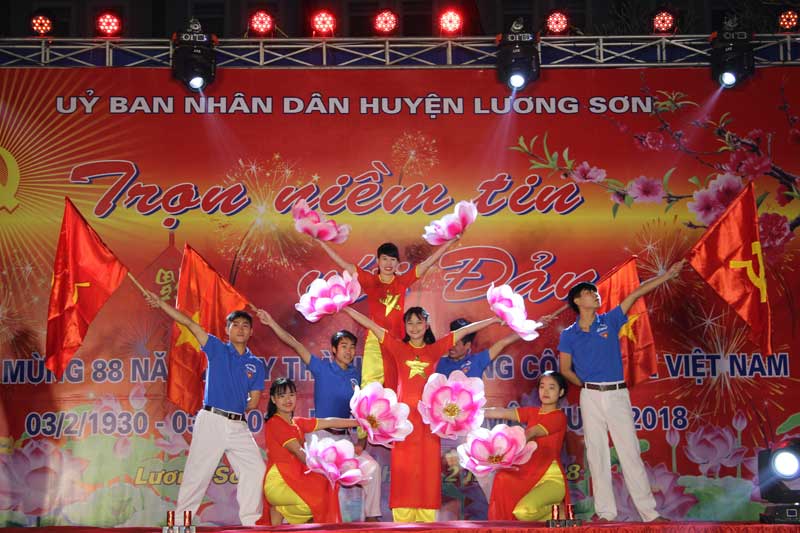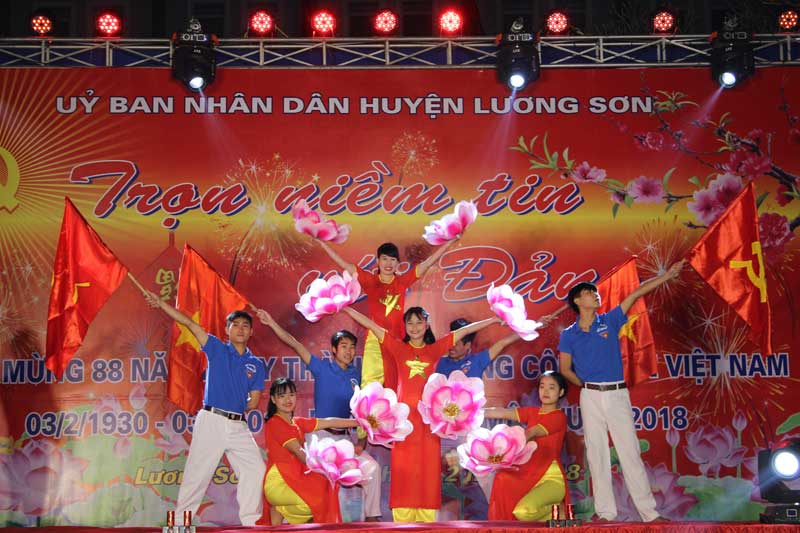
(HBO) – In order to celebrate the 88th anniversary of the foundation of the Communist Party of Vietnam (3/2/1930 - 3/2/2018) and to celebrate the New Year of 2018, the People's Committee of Luong Son District held an Exchanging Performance Night with the theme "Full Belief with the Party".
With the pride and gratitude of President Ho
Chi Minh - the beloved leader of the Vietnamese nation, the expression of a great faith to the Party, the pride of our
Party long- lasting 88 springs, the youth vanguard teams of communes of Tan Vinh, Cu Yen, Hoa Son, Luong
Son town, Nguyen Trai high school, Cheo 30/4 club and collaborators of Luong
Son District Cultural Center brought an outstanding performance to the event
program. The Art Night has 20 art performances of singing and dancing music
with the content to praise the Party, Uncle Ho, the innovative country, to
praise the love spring, solidarity of ethnic minority people in Luong Son
District.

A performance at the cultural exchange night
"Full Belief with the Party”.
The exchange night has created an atmosphere
of joy, excitement, jubilance for the local people in the district. This is
also a useful, healthy and meaningful cultural activity being held to welcome
the spring of 2018./.
With an increasingly vibrant and widespread emulation movement aimed at building cultured residential areas and cultured families, Yen Thuy District has been making steady progress toward improving both the material and spiritual well-being of its people, while fostering a civilized, prosperous, beautiful, and progressive community.
Once lacking recreational spaces and community facilities, Residential Group 2 in Quynh Lam Ward (Hoa Binh City) has recently received attention for the construction of a new, spacious, and fully equipped cultural house. The project followed the model of state support combined with public contributions in both labor and funding.
The "All people unite to build cultural life" movement, which has been effectively integrated with Kim Boi district’s socio-economic development goals, is fostering a lively spirit of emulation across local residential areas, hamlets, villages, public agencies, and enterprises. In addition, through the initiative, traditional cultural values are being preserved and promoted, while community solidarity and mutual support in poverty reduction and economic development are being strengthened.
A working delegation of the Hoa Binh provincial People’s Committee led by its Permanent Vice Chairman Nguyen Van Toan on June 11 inspected the progress of a project to build the Mo Muong Cultural Heritage Conservation Space linked to tourism services in Hop Phong commune, Cao Phong district.
Born and growing in the heroic land of Muong Dong, Dinh Thi Kieu Dung, a resident in Bo town of Kim Boi district, in her childhood was nurtured by the sweet lullabies of her grandmother and mother. These melodies deeply imprinted on her soul, becoming an inseparable part of her love for her ethnic group's culture. For over 20 years, this love for her hometown has driven Dung to research, collect, and pass down the cultural values of the Muong people to future generations.
In the final days of May, the Ethnic Art Troupe of Hoa Binh Province organized performances to serve the people in remote, mountainous, and particularly disadvantaged areas within the province. These were not just ordinary artistic shows, but they were the meaningful journeys aimed at spreading cultural values, enhancing the spiritual life of the people and contributing to the preservation of ethnic minority cultural identities.



